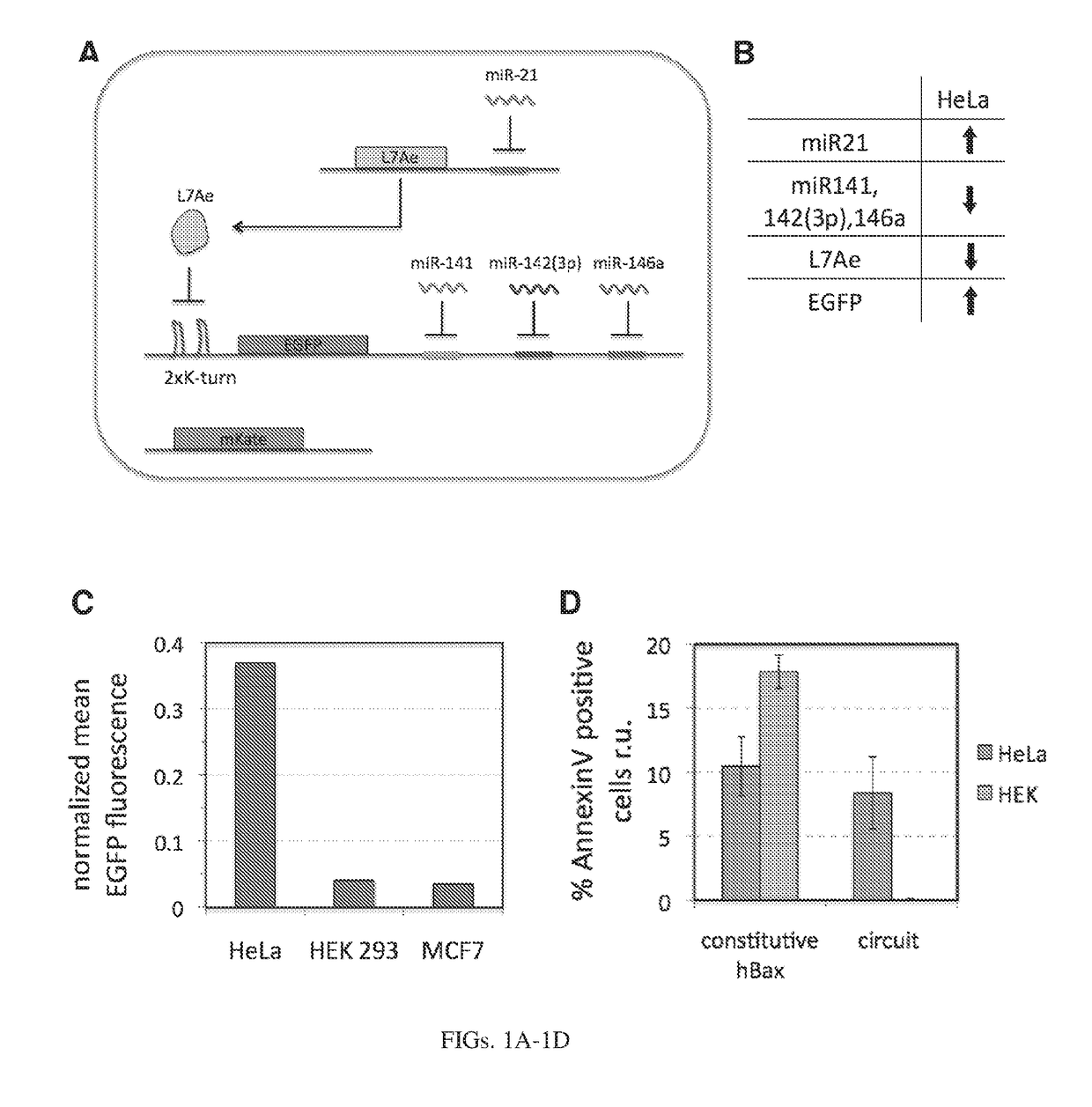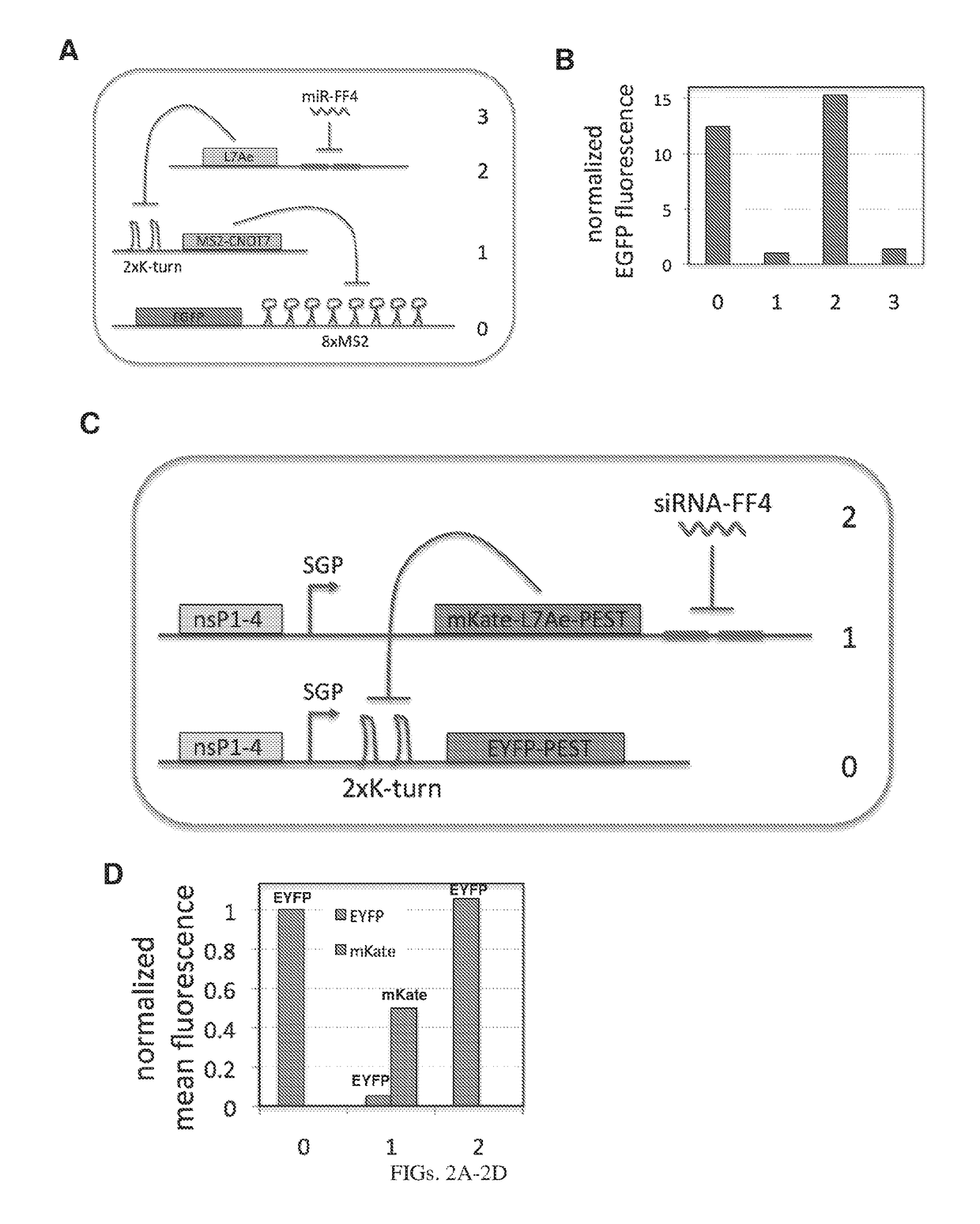Rna-based logic circuits with RNA binding proteins, aptamers and small molecules
a logic circuit and aptamer technology, applied in the field of synthetic rna-based genetic circuits, can solve the problems of low dynamic range, device not suitable for construction of scalable circuits, and no control mechanism has been developed to regulate replicon-based expression, etc., to inhibit protein production, facilitate protein degradation, and inhibit protein production
- Summary
- Abstract
- Description
- Claims
- Application Information
AI Technical Summary
Benefits of technology
Problems solved by technology
Method used
Image
Examples
example 1
[0214]In our initial circuits, we use two translational repressors, L7Ae (12) and a fusion protein MS2-CNOT7 (13). L7Ae is an archeal protein that binds K-turn and K-loop motifs with high affinity. When the motif is placed in the 3′UTR of the target mRNA, L7Ae can strongly repress translation of the output gene by blocking ribosome scanning. As has been shown, using multiple repeats of the binding motif and placing the motif close to the transcription start result in enhanced repression (14). We used two repeats of the K-turn motif with an eighteen base pair spacer from the transcription start and such configuration resulted in a very strong repression even at low doses of L7Ae. MS2 is another RNA binding protein, a coat protein from bacteriophage MS2. CNOT7 is a human deadenylase that can efficiently repress translation of mRNA, if directed to its 3′UTR (13). In our system, the reporter mRNA contains eight repeats of the MS2 coat protein binding site in the 3′UTR and MS2 is fused w...
example 2
Synthetic Circuits with RNA Binding Proteins Delivered by RNA
Materials and Methods
Cell Culture
[0227]HEK293FT and HEK293 (293-H) cell lines were purchased from Invitrogen. HeLa (CCL.2) and MCF7 (HTB-22) cell lines were originally obtained from ATCC. The performance of DNA-encoded miRNA sensors in these cell lines had been characterized previously (15). HEK293FT were freshly purchased from the supplier. HeLa, MCF7 and BHK21, although not recently authenticated, were tested for mycoplasma. All cell lines used in this study were maintained in Dulbecco's modified Eagle medium (DMEM, Cellgro) supplemented with 10% FBS (Atlanta BIO), 1% penicillin / streptomycin / L-Glutamine (Sigma-Aldrich) and 1% non-essential amino acids (HyClone) at 37° C. and 5% CO2. In the case of MCF7 cells, DMEM without phenol red was used. BHK21 cells were maintained in Eagle's Minimum Essential Medium (EMEM, ATCC) supplemented with 10% FBS.
DNA Preparation and Transfection
[0228]All transfections were carried out in 24...
example 3
RNA Circuits as a Vaccination Platform
[0338]The creation of a safe and cost-effective prophylactic / therapeutic vaccine which can induce potent broadly-neutralizing antibody (bNAb) and cytotoxic T lymphocyte (CTL) responses is urgently needed to end the global HIV / AIDS epidemic. Here we hypothesize that a programmable RNA replicon-based vaccination platform developed through a collaboration between the Weiss and Irvine groups may be used to effectively support this goal by precisely engineering and optimizing the kinetics of antigen / adjuvant expression.
Rationale and Preliminary Data
[0339]In vitro transcribed RNA as a vaccine platform is cheaper and easier to manufacture than recombinant proteins and safer than DNA to administer to patients due to the low risk of potentially harmful integration of the vector into the genome (Sahin et al. 2014). Furthermore, vaccination can be readily scaled-up to humans using synthetic lipid nanoparticle (LNP)-based delivery systems (Sahin et al. 2014...
PUM
 Login to View More
Login to View More Abstract
Description
Claims
Application Information
 Login to View More
Login to View More - R&D
- Intellectual Property
- Life Sciences
- Materials
- Tech Scout
- Unparalleled Data Quality
- Higher Quality Content
- 60% Fewer Hallucinations
Browse by: Latest US Patents, China's latest patents, Technical Efficacy Thesaurus, Application Domain, Technology Topic, Popular Technical Reports.
© 2025 PatSnap. All rights reserved.Legal|Privacy policy|Modern Slavery Act Transparency Statement|Sitemap|About US| Contact US: help@patsnap.com



